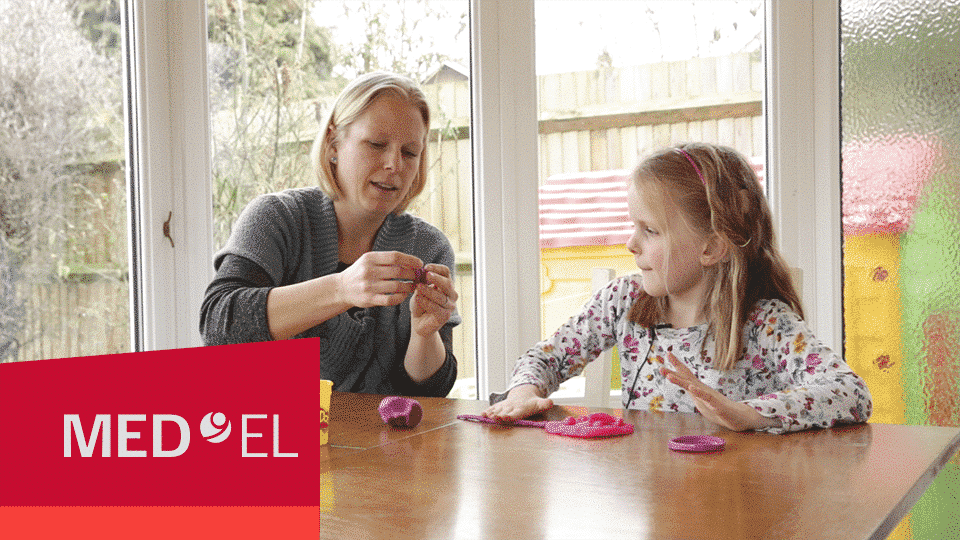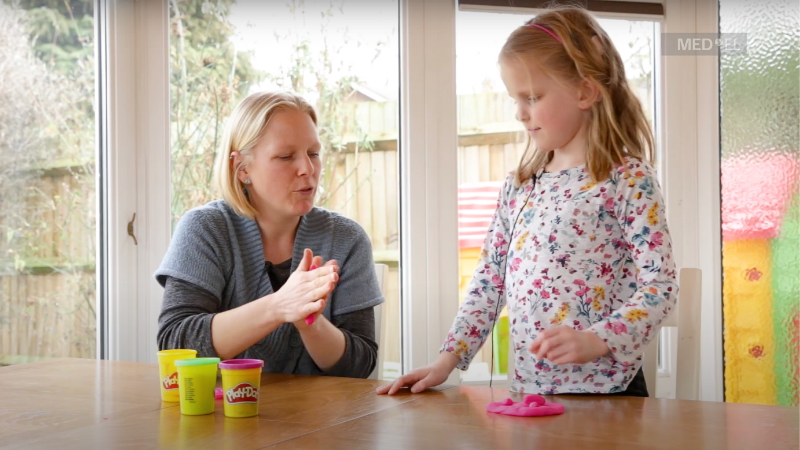
MED-EL
Published Apr 17, 2019
Rehab At Home: What Is “Acoustic Highlighting”?
Today’s Rehab At Home post is about “Acoustic Highlighting“. This is a simple technique that you can use throughout your day when talking with your child. We’re going to look more at what acoustic highlighting is, and explain some simple ways you can use acoustic highlighting at home to help your child’s speech and language development.

What Is “Acoustic Highlighting”?
Acoustic highlighting is a great strategy to use when teaching your child new sounds, words or sentence structures. We use acoustic highlighting to put emphasis on a specific sound or word to make it stand out from the rest of the phrase or sentence. When someone misunderstands a sentence, often we will use acoustic highlighting to draw to their attention to the error, for example, “No, I would like two cappuccinos and one tea please”.
Why Is “Acoustic Highlighting” Important?
Acoustic highlighting makes it easier for your child to identify the important information as it stands out in the spoken sentence.
The use of acoustic highlighting can also help your child to use clear speech. If your child says a sound incorrectly, repeat their sentence and acoustically highlight the sound they produced incorrectly, but say the word in the correct way. Do not repeat their error sound. It is important that your child hears how the sound should be produced correctly.
For example, if your child says “I can see the pish”, you can say “Yes, I can see the fish too!
How Can I Use “Acoustic Highlighting”?
Here are some ways to add acoustic highlighting to your speech:
- Add emphasis to the important word by changing your tone of voice.
- Add a sing song quality to your voice when you say the key word to draw attention to it: sing what you say!
- Say the word slightly louder or softer than the rest of the phrase: whisper it…..what shall we do?
- Pause slightly before saying the key word: if your child is telling you about his day and says, “I go to the pool today,” pause before the word /went/: “You went to the pool today.”
- Say the word more slowly to draw out the sounds they might be missing: “Oh, you are going to for a ssswim?”
In this video, Jessica and her mum are playing with playdough. Jessica’s mum adds acoustic highlighting to key words in her sentences and instructions to draw Jessica’s attention to the important information.
For example she says “Let’s make a long, thin mouth”.
Here are some other ways you can use acoustic highlighting at home:
What Activities Can We Do With Younger Children?
- Use your child’s favorite toys to teach new words. When playing with your child, think about how you can play with those toys differently and add new words to expand their vocabulary.
Use acoustic highlighting to draw their auditory attention to the new words and use them in conjunction with words they already understand.For example, when playing with cars talk about “driving the cars through the tunnel”, “my car is going to park behind the bus”, “the children need to be careful. They must cross on the pedestrian crossing, so the drivers can see them”.
- Young children will often like you to read them their favorite books over and over again. When doing so, take the opportunity to use acoustic highlighting to teach your child new words.
For example, if you have read “The Hungry Caterpillar” many times before and talked about the colors and numbers, next time add different words to describe the foods and how the caterpillar is feeling.
For example, “He ate the red crunchy apple”, “The caterpillar is tired. He is exhausted. He needs to rest”.
What Activities Can We Do With Older Children?
- When sorting the washing, teach your child to use possessives (the ‘s’ at the end of names to show ownership, for example “Mum’s bag”).
Use acoustic highlighting to draw your child’s auditory attention to the ‘s’ sound they have to add after the name “This is Dad’s shirt”, “These are Hannah’s shorts”.
- Teach your child to use ‘a’ and ‘and’ in sentences with a shopping memory game and your use of acoustic highlighting. Take turns adding items to the shopping list (not written down, but verbal) and see if you can remember them all.
For example, “I went shopping and I bought a carton of milk, and a loaf of bread.” “I went shopping and I bought a carton of milk, a loaf of bread, and a packet of biscuits”.
Use acoustic highlighting to draw your child’s attention to your use of ‘a’, ‘an’ and ‘and’ in the phrase.
Interested in more from Rehab At Home? Check out all the videos on our Rehab At Home page.
Find out more about how cochlear implants work and how they could help you or your child.
References

MED-EL
Was this article helpful?
Thanks for your feedback.
Sign up for newsletter below for more.
Thanks for your feedback.
Please leave your message below.
Thanks for your message. We will reply as soon as possible.
Send us a message
Field is required
John Doe
Field is required
name@mail.com
Field is required
What do you think?
© MED-EL Medical Electronics. All rights reserved. The content on this website is for general informational purposes only and should not be taken as medical advice. Contact your doctor or hearing specialist to learn what type of hearing solution suits your specific needs. Not all products, features, or indications are approved in all countries.

MED-EL

MED-EL



